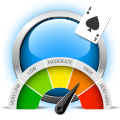Poker Variance

Variance is a killer in online poker. The upswings and downswings can affect your mood,
put you on tilt, give you a false sense of superiority, and kill your enthusiasm (often
all in one game).
Bad variance can make it difficult to assess whether you're doing the right thing or not.
On top of that, it's a kick in the teeth to be outdrawn or sucked out on when you know
you're playing well.
However, by accepting that variance is part and parcel of this great game, you can work
harder to combat it.
What Is Variance?
Variance is the fluctuation of your results over a long period of time. This can be down
to luck, bad beats, or coming up against a bunch of fish.
You might hit bad spells of variance, even when you're playing well. Of course, variance
goes both ways, and you yourself may experience periods of good variance (although most
players conveniently forget the times they sucked out on other players).
Variance affects everyone, even the great players, and anyone can be hit by bad luck at
one time or another. Losing money when you know you've made a good decision is pretty
disgusting, but spare a thought for the big-name pros who lose millions just by doing
that.
Working to Combat Variance
All is not lost, however; playing enough games is a good way to help iron out variance
and negate the swings, especially if you're a solid player.
Playing a high enough volume, and playing at the best of your abilities, is the best way
to stabilize your long-term profits.
Ways to fight variance:
- Play at a level you're comfortable with
- Improve your win rate by playing a high volume of hands
- Keep detailed stats and invest in tracking software
- Avoid tilt and work on leaks
Playing the Volume

All solid players should be keeping an eye on their win rate. Your win rate can be
described in various ways, but generally it's recorded as the number of big blinds you
pick up an hour (bb/hr), the number of big blinds you win every 100 hands (bb/100) or,
if you're using a HUD like PokerTracker, the number of big bets you're winning every 100
hands (BB/100).
Big bets are double the big blind due to Limit Hold'em variants where the betting is
different to No Limit.
A good, long-term win rate is 4-6 bb/100. Anything higher (like 8,9 or 10+) is getting
into very good territory.
But, of course, you need to play a decent volume of hands to get a good idea of your win
rate.
Results vs. Expectation
Variance is the difference between your actual results and your expected results. That
can mean bad luck as well as good, so don't just assume it's down to some idiot sucking
out on you; it's also the times you got lucky against an opponent.
Look at your win rate again. If you're expecting to win $1,000 a month on average playing
$0.50/$1.00 cash games but you're only recording $750, that can be put down to
variance.
Playing At the Right Levels
As well as playing a high volume of hands to overcome the bad luck and swings, you need
to be playing at a level that's right for you.
There's no point jumping in at the $1/2 cash games if you can't handle the pace. You can
use all the luck you want, but the skill factor of your opponents will tell in the end.
Your win rate will plummet and your bankroll will disappear.
Picking the Right Games
As well as picking the right levels, picking the right games is important too.
No Limit Hold'em, by its very nature, has more variance than Pot Limit Hold'em due to the
betting structure. If you're risking a lot of money, as you are in No Limit, the
variance increases.
Also, MTTs with big fields will have greater variance than a single-table SNG. This is
simply down to the bigger number of players involved and the effect that has on your
expectancy to win money. This stat can become skewed if you take down a big MTT,
however. Suddenly, that first-place money has given your variance on a positive
spike.
Making the Right Decisions

Poker at most lower levels includes a fair amount of luck; a lot of players (however good
they think they are) just don't have the skill level to make poker an entirely luck-free
game.
That's why it's important to play to the best of your abilities at all time. Picking the
right levels is the start, but making the right moves consistently is important too.
Revisiting hand histories and using analysis or tracking software will give you a better
idea of where you're going right (or wrong) over the long-term.
Gus Hansen: The Man Who Won (and Lost) a Fortune
Variance can lead to some pretty horrible downswings and can seriously dent your
bankroll.
But nowhere is variance seen more than in aggressive online players. Loose-aggressive or
hyper-aggressive players will be a) playing tons more pots, and b) risking more
money.
These two factors cause the perfect storm of variance and can lead to big losses.
Take Gus Hansen, for example. The Danish pro has won millions of dollars in live poker
but it's at the online "nosebleed" stakes where he's made his name in the past few
years.
However, last year he ended up recording almost $6 million of losses. In the previous
year, he finished up nearly $9 million worse off.
Playing enough hands wasn't a problem (Hansen actually played more hands last year, when
he lost least) but picking the wrong games. The Dane cited bad table selection, tilt,
and stubbornness as major factors in his disastrous downswings.
Advanced Tip: Using a Variance Calculator
You might think downswings can't be mathematically quantified, but you'd be wrong. There
are actually poker variance calculators available on the web right now.
A variance calculator is useful as a guide for experienced cash players to get a detailed
analysis of their downswing. Then they can work towards fixing them.
You'll have to enter a few variables first, including:
- Your win rate in BB/100 (the amount of money you win over a certain
time period, in this case in terms of big bets per every 100 hands where the Big Bet
is twice the big blind).
- The standard deviation in BB/100 (usually around 60-80 BB/100 for a
full-ring No Limit Hold'em cash game. This can be found tracking software like
PokerTracker)
- Number of hands for the calculator to simulate (pick a good sample,
around 50,000-100,000)
Hit the 'Calculate' button and you will be presented with a set of stats, including how
much your actual results will differ on average from your expected results.







